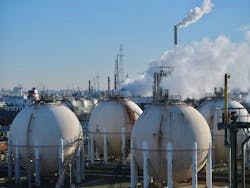Liquefied petroleum gas (LPG) is a hydrocarbon gas consisting primarily of propane, butane, or a mixture of both. Because it produces lower greenhouse gas emissions than traditional solid fuels, there's increasing demand for LPG across the world. In fact, some governments have implemented policies and initiatives to promote the use of LPG to reduce air pollution and improve public health. This increased demand puts the onus on storage terminals to use their capacity as efficiently as possible, by optimizing inventory management and safety. This can be achieved by integrating non-contacting radar level gauges into tank gauging systems.
Control’s editor-in-chief, Len Vermillion, spoke with Tomas Hasselgren, manager of global business development at Emerson, about the challenges of LPG tank gauging, and the benefits that can be achieved by using non-contacting radar level gauges rather than traditional level measurement technology.
Q: What are the main challenges for tank gauging when it comes to LPG storage tanks?
A: LPG is usually in a liquid phase when it's stored, so the tanks are pressurized or in some cases cryogenic to support the liquid phase of the LPG product.
Typically, there are two types of tanks: a bullet-shaped tank or a spherical tank. The spherical tank can normally take a larger volume than the bullet tank. It's also more complicated to build those spherical tanks. Some refrigerated tanks can take a lot more volume but are more expensive to build and more difficult to handle.
In pressurized vessels and during certain conditions such as rapid depressurization or temperature changes, the level surface is affected by boiling or foam on the surface. This can also happen when filling the tank, and that makes it difficult in these applications.
Also, the density can vary. When filling or emptying the tank, the technologies used for level measurement depend on the actual density of the product and are affected by it.
Q: There are the traditional mechanical methods and non-contacting radar measurement. Can you explain the differences between the two?
A: One is a fully electronic device without any moving parts, and the other is a mechanical device.
Mechanical devices have a float or displacer that goes down, touches the product surface, or sometimes goes into the surface. Non-contacting radar doesn't have any moving parts, meaning there's no need for maintenance, which the mechanical device requires. Also, mean time between failure is much longer for non-contacting radar gauges than mechanical devices.
Q: What are the specific benefits of radar for LPG tank gauging?
A: It's a benefit for all tanks independent of what product is stored in the tanks. The difference with LPG is that you can't access the tank; they're pressurized. You can't go into the tank, you can't maintain it, and you can't change the wire or the displacer easily on a mechanical device. Whatever you install on the tank, you must be sure it will work for a long time.
The maintenance of these tanks is normally done about every 10 years. It's important to have a device that doesn't require constant maintenance or repair. You don't have any recalibration needed and there's no drift. The density varies in these tanks, and radar isn't affected by density changes.
Q: We hear a lot about the 2-in-1 technology present in Emerson's radar solutions. Can you explain what that means and how it works?
A: It means there are two radars in the same metal housing, and they're galvanically separated with independent communication and independent power supply. The benefit for LPG tanks is you only need one tank opening for both level and the overfill prevention system (OPS). When it comes to LPG tanks, users don't want any more tank openings than needed.
The challenge users face when upgrading an existing LPG tank from a mechanical device to radar technology is the ease with which the new technology can be installed. If an existing LPG tank has only one opening available, the tank would need to be modified to enable two separate radar level gauges to be installed to support the tank gauging system and the OPS. Making that modification may be cost-prohibitive, as it would involve the tank being taken out of service, thereby impacting throughput and profitability.
However, this challenge is solved by the Rosemount™ 5900S 2-in-1 Radar Level Gauge from Emerson, which consists of two separate and independent electrical units and a common antenna. This enables a single device to be used for both tank gauging and separate OPS purposes, requiring only one tank opening and minimal or no modifications.
Q: Let’s talk about some of that available technology, especially for tank gauging, in general, and specifically for LPG.
A: Everything we do, and have been doing for the last 50 years, is based on radar measurement, and then we build a system around the level because there are so many other things needed at the site.
In general, the basic requirements are to provide accurate and reliable level and temperature measurement, perform calculations for volume, mass, density, and then you need to view it somehow on the display. We provide our own software for viewing or sending data to the SCADA, DCS, PLC or similar.
As a result, non-contacting radar technology offers an efficient and maintenance-free level measurement solution that tackles the growing need for accurate inventory management and overfill prevention for pressurized gas storage.


